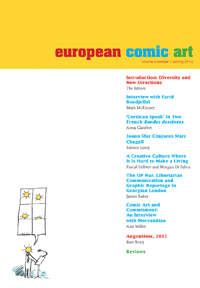
European Comic Art
ISSN: 1754-3739 (print) • ISSN: 1754-3800 (online) • 2 issues per year
Editors:
Laurence Grove, University of Glasgow
Ann Miller, University of Leicester
Anne Magnussen, University of Southern Denmark
Subjects: Cultural Studies
Published in association with the International Bande Dessinée Society
IBDS and ABDS members can access the journal online here.
Latest Issue
Volume 18 Issue 1
Introduction
Valérian et Laureline
When Pierre Christin and Jean-Claude Mézières penned the inaugural story of the science fiction comic series
Valérian et Laureline and Twentieth-Century Countercultural Shifts
Published amid post-war shifts in the science fiction (SF) genre,
Valérian and Laureline , a Pilote Serial
This article argues that numerous characteristics of
Valérian et Laureline , or How to Build a Universe Out of Its Protagonists
This article studies how the main protagonists of the French comic book series
Xombul
Valérian et Laureline 's Proto-Villain
This article looks at the first three stories of Pierre Christin and Jean-Claude Mézières
Interview with Peter Kessler
In this interview, television producer and polymath Peter Kessler reflects on the origins of his love of comics and his developing critical awareness of the artistic dimensions of the medium, which led to one of the first studies of a comics series to be published in the UK, his guide to
Exhibition Reviews
Clémentine Deroudille, Thomas Ragon and Paul Salmona, eds,